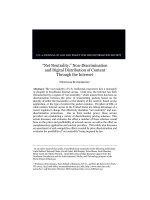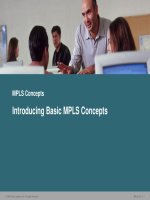Computers and digital basic computer concepts 2014 chapter01
Bạn đang xem bản rút gọn của tài liệu. Xem và tải ngay bản đầy đủ của tài liệu tại đây (2.44 MB, 63 trang )
Chapter 1
Computers and Digital Basics
Computer Concepts 2014
1
Chapter Contents
Section A: All Things Digital
Section B: Digital Devices
Section C: Digital Data Representation
Section D: Digital Processing
Section E: Password Security
Chapter 1: Computers and Digital Basics
2
1
FastPoll True/False Questions
Answer A for True and B for False
010100 Cloud computing characterized the first phase of the digital revolution.
010200 A computer’s operating system is a type of application software.
010300 Microcontrollers are special purpose microprocessors that can be embedded in
devices such as refrigerators, cars, and washing machines.
010400 A bit is a binary digit, such as a 1 or 0.
Chapter 1: Computers and Digital Basics
3
3
1
FastPoll True/False Questions
Answer A for True and B for False
010500 ASCII and Unicode are used to represent character data.
010600 A megabyte is 1024 bits.
010700 Microprocessors are a type of integrated circuit.
010800 C, COBOL, and Java are examples of programming languages.
Chapter 1: Computers and Digital Basics
4
4
1
FastPoll True/False Questions
Answer A for True and B for False
010900 A compiler converts source code to object code.
011000 The list of codes for a microprocessor’s instruction set is called machine
language.
011100 A microprocessor holds data in the interpreter register.
011200 A dictionary attack is a virus that hides out in the spelling checker for your word
processing software.
Chapter 1: Computers and Digital Basics
5
5
1
Section A: All Things Digital
The Digital Revolution
Data Processing
Personal Computing
Network Computing
Cloud Computing
Digital Society
Chapter 1: Computers and Digital Basics
6
1
Question
012100 Computers and the digital revolution have changed our lives in many fundamental
ways. If you were on the front lines of the digital revolution when computers were first
developed to break codes and calculate missile trajectories, you were most likely living in
what time period?
A. World War I
B. The Roaring Twenties
C. World War II
D. The 1960s
Chapter 1: Computers and Digital Basics
7
1
The Digital Revolution
The digital revolution is an ongoing process of social, political, and economic change brought about by
digital technology, such as computers and the Internet
The technology driving the digital revolution is based on digital electronics and the idea that electrical
signals can represent data, such as numbers, words, pictures, and music
Chapter 1: Computers and Digital Basics
8
1
The Digital Revolution
Digitization is the process of converting text, numbers, sound, photos, and video into data that can be
processed by digital devices
The digital revolution has evolved through four phases, beginning with big, expensive, standalone
computers, and progressing to today’s digital world in which small, inexpensive digital devices are
everywhere
Chapter 1: Computers and Digital Basics
9
1
The Digital Revolution
Chapter 1: Computers and Digital Basics
10
1
Data Processing
Some historians mark the 1980s as the beginning of the digital revolution, but engineers
built the first digital computers during World War II for breaking codes and calculating
missile trajectories
Computers were operated by trained technicians
Back then, processing components for computers were housed in closet-sized cabinets
that did not usually include a keyboard or display device
Chapter 1: Computers and Digital Basics
11
1
Data Processing
Data processing is based on an input-processing-output cycle
Data goes into a computer, it is processed, and then it is output
Chapter 1: Computers and Digital Basics
12
1
Personal Computing
The model for the second phase of the digital revolution, personal computing is
characterized by small, standalone computers powered by local software
Local software refers to any software that is installed on a computer’s hard drive
Chapter 1: Computers and Digital Basics
13
1
Personal Computing
Chapter 1: Computers and Digital Basics
14
1
Network Computing
The third phase of the digital revolution materialized as computers became networked
and when the Internet was opened to public use
A computer network is a group of computers linked together to share data and resources
The Internet is a global computer network originally developed as a military project, and
was then handed over to the National Science Foundation for research and academic use
Chapter 1: Computers and Digital Basics
15
1
Network Computing
The Web (short for World Wide Web) is a collection of linked documents, graphics, and
sounds that can be accessed over the Internet
During the period from 1995–2010, computing was characterized by the Web, e-mail,
multiplayer games, music downloads, and enormous software applications, such as
Microsoft Office, Norton’s Internet Security Suite, and Corel Digital Studio
Chapter 1: Computers and Digital Basics
16
1
Cloud Computing
Local applications are being eclipsed by cloud computing, which characterizes the fourth
phase of the digital revolution
Cloud computing provides access to information, applications, communications, and
storage over the Internet
The expansion of cloud computing is due in part to convergence, a process by which
several technologies with distinct functionalities evolve to form a single product
Chapter 1: Computers and Digital Basics
17
1
Cloud Computing
Chapter 1: Computers and Digital Basics
18
1
Cloud Computing
Convergence is important to the digital revolution because it created sophisticated mobile
devices whose owners demand access to the same services available from full-size
computers on their desks
Social media are cloud-based applications designed for social interaction and consumergenerated content
Chapter 1: Computers and Digital Basics
19
1
Cloud Computing
Chapter 1: Computers and Digital Basics
20
1
Digital Society
Digital technologies and communications networks make it easy to cross cultural and
geographic boundaries
Anonymous Internet sites, such as Freenet, and anonymizer tools that cloak a person’s
identity, even make it possible to exercise freedom of speech in situations where reprisals
might repress it
Citizens of free societies have an expectation of privacy
Intellectual property refers to the ownership of certain types of information, ideas, or
representations
Chapter 1: Computers and Digital Basics
21
1
Digital Society
Digital technology is an important factor in global and national economies, in addition to affecting the
economic status of individuals
Some individuals are affected by the digital divide, a term that refers to the gap between people who
have access to technology and those who do not
Digital technology permeates the very core of modern life
Chapter 1: Computers and Digital Basics
22
1
Section B: Digital Devices
Computer Basics
Computer Types and Uses
Microcontrollers
Chapter 1: Computers and Digital Basics
23
1
Computer Basics
A computer is a multipurpose device that accepts input, processes data, stores data, and produces
output, all according to a series of stored instructions
Chapter 1: Computers and Digital Basics
24
1
Computer Basics
Computer input is whatever is typed, submitted, or transmitted to a computer
system
Output is the result produced by a computer
Data refers to the symbols that represent facts, objects, and ideas
Computers manipulate data in many ways, and this manipulation is called
processing
Central Processing Unit (CPU)
Microprocessor
Chapter 1: Computers and Digital Basics
25









